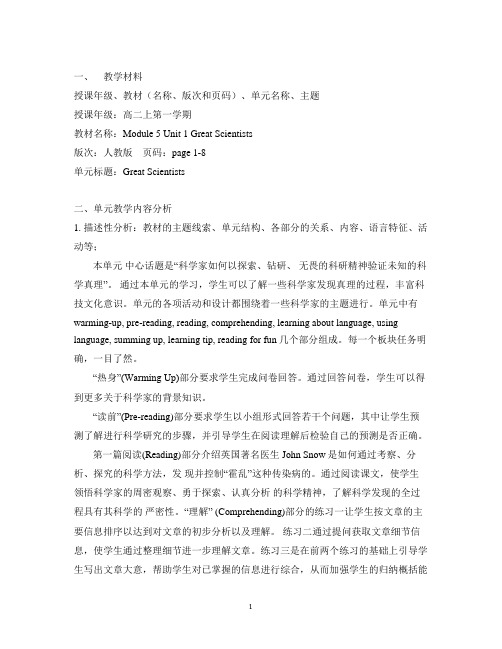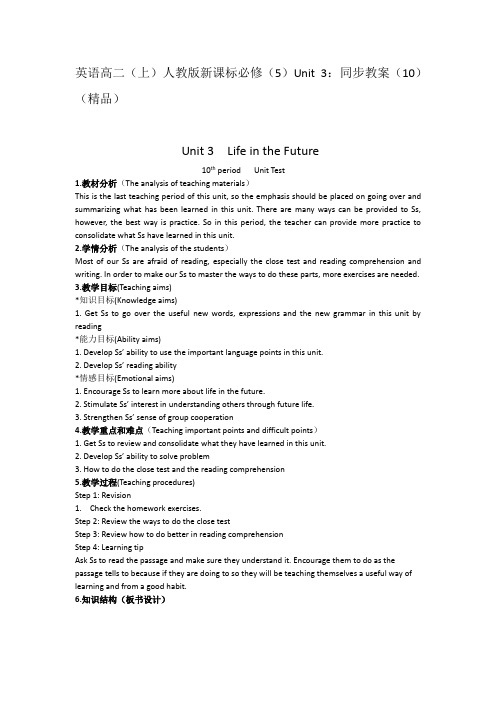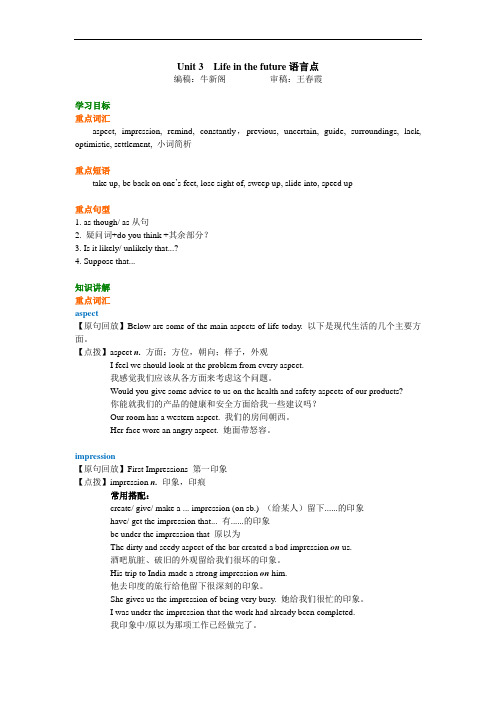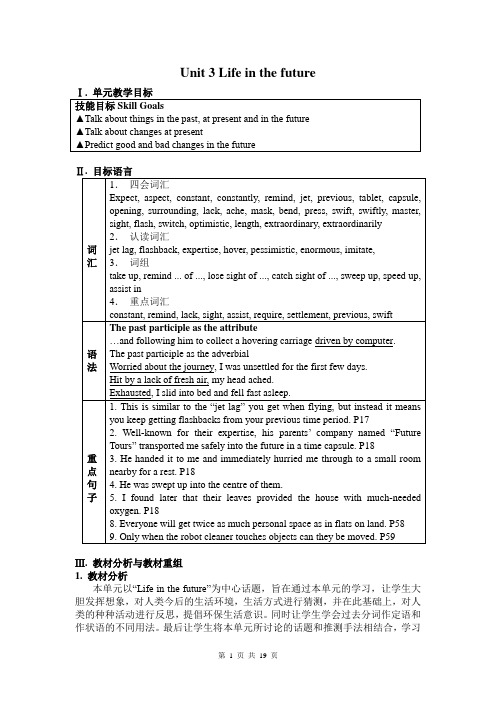高二英语必修五unit3教案知识讲解
人教版英语必修五Unit 3单元整体教学教案

一、教学材料授课年级、教材(名称、版次和页码)、单元名称、主题授课年级:高二上第一学期教材名称:Module 5 Unit 1 Great Scientists版次:人教版页码:page 1-8单元标题:Great Scientists二、单元教学内容分析1. 描述性分析:教材的主题线索、单元结构、各部分的关系、内容、语言特征、活动等;本单元中心话题是“科学家如何以探索、钻研、无畏的科研精神验证未知的科学真理”。
通过本单元的学习,学生可以了解一些科学家发现真理的过程,丰富科技文化意识。
单元的各项活动和设计都围绕着一些科学家的主题进行。
单元中有warming-up, pre-reading, reading, comprehending, learning about language, using language, summing up, learning tip, reading for fun几个部分组成。
每一个板块任务明确,一目了然。
“热身”(Warming Up)部分要求学生完成问卷回答。
通过回答问卷,学生可以得到更多关于科学家的背景知识。
“读前”(Pre-reading)部分要求学生以小组形式回答若干个问题,其中让学生预测了解进行科学研究的步骤,并引导学生在阅读理解后检验自己的预测是否正确。
第一篇阅读(Reading)部分介绍英国著名医生John Snow是如何通过考察、分析、探究的科学方法,发现并控制“霍乱”这种传染病的。
通过阅读课文,使学生领悟科学家的周密观察、勇于探索、认真分析的科学精神,了解科学发现的全过程具有其科学的严密性。
“理解” (Comprehending)部分的练习一让学生按文章的主要信息排序以达到对文章的初步分析以及理解。
练习二通过提问获取文章细节信息,使学生通过整理细节进一步理解文章。
练习三是在前两个练习的基础上引导学生写出文章大意,帮助学生对已掌握的信息进行综合,从而加强学生的归纳概括能力,同时通过理解后的语言输出活动帮助学生更完整地理解文章。
英语高二(上)人教版新课标必修(5)unit 3:同步教案(

英语高二(上)人教版新课标必修(5)Unit 3:同步教案(10)(精品)Unit 3 Life in the Future10th period Unit Test1.教材分析(The analysis of teaching materials)This is the last teaching period of this unit, so the emphasis should be placed on going over and summarizing what has been learned in this unit. There are many ways can be provided to Ss, however, the best way is practice. So in this period, the teacher can provide more practice to consolidate what Ss have learned in this unit.2.学情分析(The analysis of the students)Most of our Ss are afraid of reading, especially the close test and reading comprehension and writing. In order to make our Ss to master the ways to do these parts, more exercises are needed.3.教学目标(Teaching aims)*知识目标(Knowledge aims)1. Get Ss to go over the useful new words, expressions and the new grammar in this unit by reading*能力目标(Ability aims)1. Develop Ss’ ability to use the important language points in this unit.2. Develop Ss’ reading ability*情感目标(Emotional aims)1. Encourage Ss to learn more about life in the future.2. Stimulate Ss’ interest in understanding others through future life.3. Strengthen Ss’ sense of group cooperation4.教学重点和难点(Teaching important points and difficult points)1. Get Ss to review and consolidate what they have learned in this unit.2. Develop Ss’ ability to solve problem3. How to do the close test and the reading comprehension5.教学过程(Teaching procedures)Step 1: Revision1.Check the homework exercises.Step 2: Review the ways to do the close testStep 3: Review how to do better in reading comprehensionStep 4: Learning tipAsk Ss to read the passage and make sure they understand it. Encourage them to do as the passage tells to because if they are doing to so they will be teaching themselves a useful way of learning and from a good habit.6.知识结构(板书设计)1.课堂提问(Questions)1) How can you know the answer?2) what is the key sentence of this passage or paragraph?3) How can we translate this sentence?2.练习和作业(Practice and homework)完形填空(A. B 层全做)阅读下面短文,掌握其大意,然后从各题所给的四个选项(A、B、C和D)中,选出最佳选项。
高二英语必修五unit3教案(完整资料)

Unit 3 Life in the futureA teaching design for oral practiceTeaching Contents:Oral practice based on the reading passage on page17 to page18.1. Orally, answer several questions according to the text.2. Practise two topics:1) What do you suppose the future transportation will be like?2) Imagine where the house will be built in the future ?3. Listening and retelling.Teaching aims:1. Inspire the students to imagine the future life.2. Inspire the students to say something about the future transportation and housing.3. To improve the students’ oral ability.Teaching Important & difficult point::1. Inspire the students to imagine the future life and use the proper expressions.2. Enable the students to understand the meaning of the text, and say somethingaccording to the text.3. To improve the students’ oral ability.Teaching methods:reading; asking and answering activity; pair or group work.Teaching Aids: A computer, multmedia.Teaching procedures:Step1: Lead-in .Enjoy a short video, cut from a science fiction film I, robot, to lead the students to imagine the future world.Step2: Fast ReadingAsk the students to read the text quickly, then find out the main idea of the text, and answer several questions according to each paragraph.purpose: These questionts are simple questions, just to help the students get a brief acquaintance to the future world described in the text.Step3: Listening and retelling according to paragraph 4. Show some tips to help the students retell the sentences.Purpose: This exercise is a practice for oral test part C in NCEE.Step4: Design two topics while talking about the hovering carriage and Wang Ping’s house. Practise the dialogues of making predictions.Topic 1: What do you suppose the future transportation will be like?Topic 2: Imagine where the house will be built in the future ?The students may use these structures :I suppose the transportation will be something like a ….I suppose , in the future, the house will be built in…..I imagine that ….Purpose: To practise the structure orally I suppose that… , I imagine that.. . Step5: Summary of the text orally.This passage mainly tells us about a boy named Li Qiang”s trip to the future. It tells us how he got to the future, how he felt and what he had seen.Step6: Discussion.“What’s the writer’s attitude towards the future, optimistic or pessimistic?”“How do you know? “The students may begin like these :•In my opinion, the writer’s attitude towards the future is _________ .•As far as I am concerned, the writer feels _________ to the future.•I think the writer has an _________ view of the future.Purpose: To learn to analyze the writer’s attitude and express your conclusion. Step7 Homework1. To talk with your chairmate on the topic: Imagine, what the future world will be?2. Review the reading passage and find out the difficult language points to you.3. Finish exercises 1,2&4 on page 19.4. Review the words and phrases of this unit. A dictation tomorrow.Display on the blackboardUnit 3 Life in the Futurewh- do you suppose ….?I suppose …..I imagine that….And some words, perhaps they will be: science fiction film, high-tech, time tunnelPs: Display on the screenStep 1. Skimming:Skim through the passage and get its general idea.The passage is mainly about.A.how Li Qiang was transported to the future.B.how Li Qiang got to the future and his first impression of it.C.what the life was like in the future.D.the introduction of the “Future Tours ”company.1. What is a “time lag ”?“Time lag ’’is similar to the “jet lag ”. It means a person gets flashbacks from his previous time period.2.Who guides my trip?3. And who transported us to the future?Wang Ping ’s parents ’company transported us to the future.My friend Wang Ping is my guide to the future.1.How did I feel as soon as I wastransported to the future?I thought it was difficult to tolerate. I was hit by the lack of fresh air. 2. How did Wang Ping solve this problem?Wang Ping gave a mask to me and hurried me through to a small room nearby to have a rest.C. he felt a bit homesick.D. he was hit by a lack of fresh air.Hit by a lack of fresh air, my head ached.1. What did Wang Ping ’s house look like?large, bright and cleanHis house is a large bright, clean room.It had a green wall, a brown floor and soft lighting.Discussionpessimistic1.To talk with your chairmate on the topic:Imagine, what the future world will be?2.Review the reading passage and find outthe difficult language points to you.3.Finish exercises 1&2on page 19.4.Review the words and phrases of thisunit. A dictation tomorrow.Ten wordsfrom “lack”to “safety belt”.HomeworkThe Fifth Element.。
英语高二(上)人教版新课标必修(5)unit3:同步教案(5)(精品)

英语高二(上)人教版新课标必修(5)Unit 3:同步教案(5)(精品)Unit 3 Life in the Future5th period reading (II) I have seen amazing things1.教材分析(the analysis of teaching materials)This Unit talks about life in the future. This passage mainly talks about a visit to a space station. With this background, the Ss can better cast a light on the future life.2.学情分析(the analysis of the students)From the first reading“First Impressions”, the Ss experience a wonderful future travel. With this basis, they can go on a further study about amazing things in the future life.3.教学目标(Teaching aims)*知识目标(Knowledge aims)1.Let the Ss understand the meanings of the new words as well as their usages.\2.Let the Ss know about some imaginary amazing things .*能力目标(Ability aims)1. Make the Ss to conclude the structure of the passage.*情感目标(Emotion aims)Through this passage, the Ss can open their mind to the space life, which can develop their imagination as well as a hope for the future life.4.教学重点和难点(teaching important points and difficult points)a. Help students extend the knowledge about future experience.b. Pronounce the new words correctly and know relative usages.5.教学过程(Teaching procedures)Step I: Pre-readingWhat does amazing mean? Do you know the amazing things?Step II: ReadingTask 1: Fast ReadingWhat is the shape of the space station? How many stops did I have?Task 2: Careful readingListen to the tape and try to fill in the form on p23. Step III: Words and expressions1.instant n.瞬间 in an instantadj.立即的一…就…the instant/instantly2.turn into变成turn in 上交turn up 出现,调高turn down 拒绝,调低turn out 结果是turn to 转向,向…求助3.副词/介词短语放句首+谓语+主语(名词非代词)e.g: Here comes the bus. Under the tree sits a boy.6.知识结构(板书设计)副板书:主板书:adj.立即的一…就…the instant/instantly2. turn into变成turn in 上交turn up 出现,调高turn down 拒绝,调低turn out 结果是turn to 转向,向…求助3.副词/介词短语放句首+谓语+主语(名词非代词)e.g: Here comes the bus. Under the tree sits a boy.7.问题研讨(课堂提问,练习和作业设计)1.课堂提问(questions)(1)What does amazing mean? Do you know the amazing things?(2 ) What is the shape of the space station? How many stops did I have?2.作业(homework)BC类:read the new words twice from citizen to motivation.ABC类:① You see the lightning ___ it happens, but you hear the thunder later.A. the instantB. for an instantC. on the instantD. in an instant② At the foot of the mountains _______.A. a village lieB. lies a villageC. does a village lieD. lying a village③当情况变得非常糟糕时,我向我的家人寻求帮助。
高二英语人教版必修五Unit3教学设计教案

高二英语人教版必修五Unit3教学设计教案教学设计教案Unit 3 Travel journalTeaching Objectives:1. Enable students to use the target language to describedifferent types of travel experiences.2. Develop students’ reading and speaking skills.3. Enhance students’ vocabulary and grammar related to traveland tourism.Teaching Procedures:Step 1: Pre-reading1. Show students some pictures of famous tourist attractions around the world, such as the Great Wall, the Eiffel Tower, Taj Mahal, etc.2. Ask students to discuss in pairs or small groups what kind of travel experience they would like to have and the reasons why.3. Have a class discussion and share some ideas.Step 2: Vocabulary building1. Give students a list of words related to travel and tourism.2. Provide definitions for the words and ask students to matchthe words with the definitions.3. Check the answers as a class and explain any difficult vocabulary.第1页/共4页Step 3: Reading comprehension1. Divide the class into small groups and give each group atravel journal.2. Instruct students to quickly skim the journal and discuss in their groups what kind of travel experience the journal describes.3. Ask each group to share their ideas with the class and explain their reasons.4. Have students read the journal more carefully and answer the following questions individually:a. What was the main purpose of the trip?b. What did the author see and do during the trip?c. How did the author feel about the trip?d. What were the challenges the author faced during the trip?5. Discuss the answers as a class and provide any necessary explanations.Step 4: Speaking practice1. Divide the class into pairs and ask students to imagine they are planning a trip together.2. Instruct each pair to choose a destination and discuss their travel plans, including the purpose of the trip, places to visit, activities to do, etc.3. After a few minutes of discussion, have some pairs share their plans with the class.Step 5: Grammar focus1. Introduce the past continuous tense to students using examples from the travel journal.2. Explain the formation of the past continuous tense and its usage in describing past actions and events that were in progress ata specific moment in the past.3. Provide more examples and ask students to practice using the past continuous tense in pairs or small groups.Step 6: Consolidation1. Show students a video clip or slideshow of different travel experiences, including adventure travel, cultural travel, volunteer travel, etc.2. Ask students to take notes on the different types of travel experiences and the reasons why people choose them.3. Have a class discussion and share the notes.Step 7: Homework1. Ask students to write a short travel journal entry about a memorable travel experience they have had or would like to have in the future.2. Encourage students to use the past continuous tense to describe the actions and events during their travel experience.3. Collect the journal entries in the next class for feedback and correction.Assessment:1. Observe students’ participation in class discussions and group activities.2. Evaluate students’ understanding of the reading comprehension questions.第3页/共4页3. Assess students’ use of the past continuous tense in their speaking and writing tasks.。
高二英语必修五unit3教案

Unit 3 Life in the futureA teaching design for oral practiceTeaching Contents:Oral practice based on the reading passage on page17 to page18.1. Orally, answer several questions according to the text.2.Practise two topics:1) What do you suppose the future transportation willbe like2) Imagine where the house will be built in the future3. Listening and retelling.Teaching aims:1.Inspire the students to imagine the future life.2.Inspire the students to say something about the future transportation andhousing.3.To improve the students’ oral ability.Teaching Important & difficult point::1.Inspire the students to imagine the future life and use the properexpressions.2.Enable the students to understand the meaning of the text, and say somethingaccording to the text.3.To improve the students’ oral ability.Teaching methods:reading; asking and answering activity; pair or group work.Teaching Aids: A puter, multmedia.Teaching procedures:Step1: Lead-in .Enjoy a short video, cut from a science fiction film I, robot, to lead the students to imagine the future world.Step2: Fast ReadingAsk the students to read the text quickly, then find out the main idea ofthe text,and answer several questions according to each paragraph.purpose: These questionts are simple questions, just to help the students get a brief acquaintance to the future world described in the text. Step3:Listening and retelling according to paragraph 4. Show some tips to help the students retell the sentences.Purpose: This exercise is a practice for oral test part C in NCEE. Step4:Design two topics while talking about the hovering carriage and Wang Ping’s house. Practise the dialogues of making predictions.Topic 1: What do you suppose the future transportation will be like Topic 2: Imagine where the house will be built in the futureThe students may use these structures :I suppose the transportation will be something like a ….I suppose , in the future, the house will be built in…..I imagine that ….Purpose: To practise the structure orally I suppose that… , I imagine that.. .Step5: Summary of the text orally.This passage mainly tells us about a boy named Li Qiang”s trip to the future. It tells us how he got to the future, how he felt and what he had seen. Step6: Discussion.“What’s the writer’s attitude towards the future, optimistic orpessimistic”“How do you know “The students may begin like these :•In my opinion, the writer’s attitude towards the future is _________ .•As far as I am concerned, the writer feels _________ to the future.•I think the writer has an _________ view of the future.Purpose: To learn to analyze the writer’s attitude and express your conclusion.Step7 Homework1. To talk with your chairmate on the topic:Imagine, what the future world willbe2. Review the reading passage and find out the difficult language points to you.3. Finish exercises 1,2&4 on page 19.4. Review the words and phrases of this unit. A dictation tomorrow.Display on the blackboard Unit 3 Life in the Future wh- do you suppose …. I suppose ….. I imagine that ….And some words, perhaps they will be: science fiction film, high-tech, time tunnelPs: Display on the screenStep 1. Skimming:Skim through the passage and get its general idea.The passage is mainly about.A.how Li Qiang was transported to the future.B.how Li Qiang got to the future and his first impression of it.C.what the life was like in the future.D.the introduction of the “Future Tours ”company.Go through the first paragraph (Para.1) quickly, then answer the following questions:1. What is a “time lag ”?2.Who guides my trip?3.How did he get to the future?Step 2. Detailed reading1. What is a “time lag ”?“Time lag ’’is similar to the “jet lag ”. It means a person gets flashbacks from his previous time period.2.Who guides my trip?3. And who transported us to the future?Wang Ping ’s parents ’company transported us to the future.My friend Wang Ping is my guide to the future.Para.3Go through the third paragraph, then tryto answer the following questions.1. How did I feel as soon as I was transported to the future?2. How did Wang Ping solve this problem?3. What do you think has caused this kind of problem that Li Qiang ’s head ached?1.How did I feel as soon as I wastransported to the future?I thought it was difficult to tolerate. I was hit by the lack of fresh air. 2. How did Wang Ping solve this problem?Wang Ping gave a mask to me and hurried me through to a small room nearby to have a rest.C. he felt a bit homesick.D. he was hit by a lack of fresh air.Hit by a lack of fresh air, my head ached.computer The hovering carriage is driven by ________ . These carriages _____above the ground and by ______or ________ down in your seat, you can drive it swiftly.float bending pressingPara.4Read the fourth paragraph quickly, thenanswer the following questions:1.What did Wang Ping’s house look like?2.What was the green wall made of ?3. What ’s the purpose of building this kind of green wall?1. What did Wang Ping ’s house look like?large, bright and cleanHis house is a large bright, clean room.It had a green wall, a brown floor and soft lighting.2. What was the green wall made of ?3.What ’s the purpose of building this kind of green wall?The green wall was made of trees.The leaves of the trees will provide much-needed oxygen to the house.Visiting Wang Ping ’s HomeThat is a _______________house, with a large,_____ and ____ room. It had a ______ ______, soft _______ and a _____ ____ which is actually _____. The _____ of the trees provided the room with ____________ _______. By flashing a ______ on the computer screen, bright clean green wallleavesoxygenswitchRetellstrange-looking brown floor lighting trees much-needed Imagine where the house will bebuilt in the future ?Topic :I suppose , in the future, house will be built in ….I imagine that ….This passage mainly tells us about ____________________________________________________________________Li Qiang ’s first trip to the future. It tells us how he got to the future, how he felt and what he had seen.What ’s the writer ’s attitudetowards the future, optimistic or pessimistic?How do you know?optimisticpessimistic•In my opinion, the writer ’s attitude towards the future is _________.•As far as I am concerned, the writer feels _________ to the future. •I think the writer has an _________view of the future.1.To talk with your chairmate on the topic:Imagine, what the future world will be?2.Review the reading passage and find out the difficult language points to you.3.Finish exercises 1&2on page 19.4.Review the words and phrases of this unit. A dictation tomorrow.Ten words from “lack ”to “safety belt ”.HomeworkPs: Videos are from I, Robot and The Fifth Element.。
高中英语必修五知识讲解 Unit 3 Life in the future语言点

Unit 3 Life in the future语言点编稿:牛新阁审稿:王春霞学习目标重点词汇aspect, impression, remind, constantly,previous, uncertain, guide, surroundings, lack, optimistic, settlement, 小词简析重点短语take up, be back on one’s feet, lose sight of, sweep up, slide into, speed up重点句型1. as though/ as从句2. 疑问词+do you think +其余部分?3. Is it likely/ unlikely that...?4. Suppose that...知识讲解重点词汇aspect【原句回放】Below are some of the main aspects of life today. 以下是现代生活的几个主要方面。
【点拨】aspect n.方面;方位,朝向;样子,外观I feel we should look at the problem from every aspect.我感觉我们应该从各方面来考虑这个问题。
Would you give some advice to us on the health and safety aspects of our products?你能就我们的产品的健康和安全方面给我一些建议吗?Our room has a western aspect. 我们的房间朝西。
Her face wore an angry aspect. 她面带怒容。
impression【原句回放】First Impressions 第一印象【点拨】impression n.印象,印痕常用搭配:create/ give/ make a ... impression (on sb.) (给某人)留下......的印象have/ get the impression that... 有......的印象be under the impression that 原以为The dirty and seedy aspect of the bar created a bad impression on us.酒吧肮脏、破旧的外观留给我们很坏的印象。
高中英语新人教必修五 Unit3 Life in the future单元教案

Unit 3 Life in the futureⅢ. 教材分析与教材重组1. 教材分析本单元以“Life in the future”为中心话题,旨在通过本单元的学习,让学生大胆发挥想象,对人类今后的生活环境,生活方式进行猜测,并在此基础上,对人类的种种活动进行反思,提倡环保生活意识。
同时让学生学会过去分词作定语和作状语的不同用法。
最后让学生将本单元所讨论的话题和推测手法相结合,学习怎样写report。
1.1 Warming Up 部分利用一个关于“住”和“行”的对比研究表格引导学生回顾过去,认识现在和展望未来。
通过这一活动,引发学生对过去,现在和未来的思考,使学生对将要阅读的文章有个知识准备。
1.2 Pre-reading 部分让学生充分运用发散思维,先列举当今世界人类面临的一些突出问题,然后要求学生思考为什么会产生这些问题,这些问题中哪些在未来社会仍然可能存在,哪些将会被克服,哪些将会恶化。
为下面的阅读做了铺垫。
1.3 Reading 部分通过一封发自未来的电子邮件,讲述了作者Li Qiang怎样安全到达“未来世界”,他对“未来世界”的印象,以及“未来世界”的日常生活方式和交通工具情况。
阅读时要把重点放在“未来世界”生活与当今生活的不同点上。
1.4 Comprehending 部分设计了三个教学活动来加深学生对Reading部分的理解。
第一个活动要求学生通过阅读找出“未来世界”在以下几个方面的变化:跨时空旅行,交通,住房,城镇环境和空气质量。
接着让学生在此基础上得出自己的结论,哪些变化好,哪些变化不好,并说明理由。
第二个活动要求学生通过阅读来判断Li Qiang对“未来世界”的态度是乐观的还是悲观的。
学生要在文中找出支持自己观点的论据,尽可能说服别人。
第三个活动让学生想象一下Li Qiang 将会去参加哪些活动。
这样既鼓励学生展开丰富的想象,又为Using Language 部分的语篇学习做了铺垫。
- 1、下载文档前请自行甄别文档内容的完整性,平台不提供额外的编辑、内容补充、找答案等附加服务。
- 2、"仅部分预览"的文档,不可在线预览部分如存在完整性等问题,可反馈申请退款(可完整预览的文档不适用该条件!)。
- 3、如文档侵犯您的权益,请联系客服反馈,我们会尽快为您处理(人工客服工作时间:9:00-18:30)。
Unit 3 Life in the futureA teaching design for oral practiceTeaching Contents:Oral practice based on the reading passage on page17 to page18.1. Orally, answer several questions according to the text.2. Practise two topics:1) What do you suppose the future transportation will be like?2) Imagine where the house will be built in the future ?3. Listening and retelling.Teaching aims:1. Inspire the students to imagine the future life.2. Inspire the students to say something about the future transportation and housing.3. To improve the students’ oral ability.Teaching Important & difficult point::1. Inspire the students to imagine the future life and use the proper expressions.2. Enable the students to understand the meaning of the text, and say somethingaccording to the text.3. To improve the students’ oral ability.Teaching methods:reading; asking and answering activity; pair or group work.Teaching Aids: A computer, multmedia.Teaching procedures:Step1: Lead-in .Enjoy a short video, cut from a science fiction film I, robot, to lead the students to imagine the future world.Step2: Fast ReadingAsk the students to read the text quickly, then find out the main idea of the text, and answer several questions according to each paragraph.purpose: These questionts are simple questions, just to help the students get a brief acquaintance to the future world described in the text.Step3: Listening and retelling according to paragraph 4. Show some tips to help the students retell the sentences.Purpose: This exercise is a practice for oral test part C in NCEE.Step4: Design two topics while talking about the hovering carriage and Wang Ping’s house. Practise the dialogues of making predictions.Topic 1: What do you suppose the future transportation will be like?Topic 2: Imagine where the house will be built in the future ?The students may use these structures :I suppose the transportation will be something like a ….I suppose , in the future, the house will be built in…..I imagine that ….Purpose: To practise the structure orally I suppose that… , I imagine that.. . Step5: Summary of the text orally.This passage mainly tells us about a boy named Li Qiang”s trip to the future. It tells us how he got to the future, how he felt and what he had seen.Step6: Discussion.“What’s the writer’s attitude towards the future, optimistic or pessimistic?”“How do you know? “The students may begin like these :•In my opinion, the writer’s attitude towards the future is _________ .•As far as I am concerned, the writer feels _________ to the future.•I think the writer has an _________ view of the future.Purpose: To learn to analyze the writer’s attitude and express your conclusion. Step7 Homework1. To talk with your chairmate on the topic: Imagine, what the future world will be?2. Review the reading passage and find out the difficult language points to you.3. Finish exercises 1,2&4 on page 19.4. Review the words and phrases of this unit. A dictation tomorrow.Display on the blackboardUnit 3 Life in the Futurewh- do you suppose ….?I suppose …..I imagine that….And some words, perhaps they will be: science fiction film, high-tech, time tunnelPs: Display on the screenStep 1. Skimming:Skim through the passage and get its general idea.The passage is mainly about.A.how Li Qiang was transported to the future.B.how Li Qiang got to the future and his first impression of it.C.what the life was like in the future.D.the introduction of the “Future Tours ”company.1. What is a “time lag ”?“Time lag ’’is similar to the “jet lag ”. It means a person gets flashbacks from his previous time period.2.Who guides my trip?3. And who transported us to the future?Wang Ping ’s parents ’company transported us to the future.My friend Wang Ping is my guide to the future.1.How did I feel as soon as I wastransported to the future?I thought it was difficult to tolerate. I was hit by the lack of fresh air. 2. How did Wang Ping solve this problem?Wang Ping gave a mask to me and hurried me through to a small room nearby to have a rest.C. he felt a bit homesick.D. he was hit by a lack of fresh air.Hit by a lack of fresh air, my head ached.1. What did Wang Ping ’s house look like?large, bright and cleanHis house is a large bright, clean room.It had a green wall, a brown floor and soft lighting.Discussionpessimistic1.To talk with your chairmate on the topic:Imagine, what the future world will be?2.Review the reading passage and find outthe difficult language points to you.3.Finish exercises 1&2on page 19.4.Review the words and phrases of thisunit. A dictation tomorrow.Ten wordsfrom “lack”to “safety belt”.HomeworkThe Fifth Element.。
